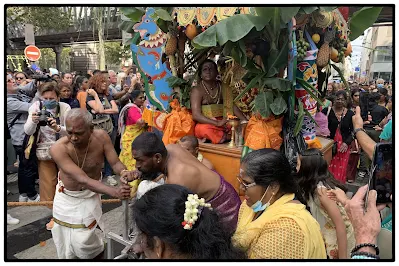Voilà,
hier matin ma fille et moi sommes allés dans le 18ème arrondissement de Paris entre le métro La Chapelle et la gare du Nord pour assister à la procession du dieu Ganesh dans le quartier indien. Décorées de nombreuses
guirlandes, de fleurs fraîches, de régimes entiers de bananes, de noix
de coco et de feuilles d'aréquiers le char abrite la
statue du dieu à tête d'éléphant.
Ensuite ont défilé des femmes portant sur
leurs têtes des pots de terre cuite dans lesquels brûle du camphre...
....des chanteurs des musiciens des joueurs de flûte, de nageshvaram et de
tambour, des danseurs avec sur leurs épaules le
grand arceau de plumes de paon que les indiens appellent kavadi
J'ai aperçu,
tiré par des femmes tenant deux grandes cordes en fibre végétale
de vingt mètres chacune entièrement
recouvert d'étoffes rouges, un autre char ...
.... celui de Muruga le frère de Ganesh
et aussi celui de la déesse Durga (qui avait l'air de bien s'ennuyer)
Tout au long du parcours, des offrandes bénies,
des friandises et des boissons fraîches
Des noix de coco ont aussi été disposées en tas devant les
magasins des commerçants. La noix de coco symbolise la dureté illusoire
du monde, sa chair nos actions individuelles, et l’eau qu'elle contient représente
l’égoïsme humain.
En brisant la noix de coco, chacun se libère et offre
son cœur à la bénédiction de Ganesh.










Our distant relative by marriage, who was born in India, had an immense collection of Ganesha images, including paintings, sculpture, and other types of images. So I am very happy to see these photos.
RépondreSupprimerbest, mae at maefood.blogspot.com
Waouh, ça devait être impressionnant. J'aime la coutume de la noix de coco.
RépondreSupprimerIt's good that you can spend time with your daughter-- especially when you can enjoy festivities like this.
RépondreSupprimerI'm indian and delighted to read this! Actually the kavadi is for Lord Muruga the brother of lord ganesh. Lord Muruga is very famous in the southern states of india. The customs you have shared is more specific to the tamil culture which is prevalent in Tamil nadu a southern state of india :)
RépondreSupprimerThe costumes are dazzling
RépondreSupprimerBeautiful. I love all the colors. Wow.
RépondreSupprimerThank you for joining the Awww Mondays Blog Hop.
Have a fabulous Awww Monday and week. ☺
The festival looks fun and colorful. Great photos. Have a wonderful week!
RépondreSupprimerWhat an amazing festival. With bunches of bananas. And broken coconuts.
RépondreSupprimerWhat a fascinating experience - I'm glad you shared it with us at http://image-in-ing.blogspot.com/2023/08/the-ever-changing-sky.html
RépondreSupprimerSo colorful! Thanks for sharing.
RépondreSupprimerGreat insight - lucky you! #PictorialTuesday
RépondreSupprimerInteresting about the coconuts, and sounds so true. How do women do that with pots on their head? I'm sure I would break mine. Thanks for sharing your day.
RépondreSupprimerWow. This was very interesting to read. I don`t know about before.
RépondreSupprimerHappy MosaicMonday
Thank you so much being part at
MosaicMonday
Have a fine week. Greetings by Heidrun
This looks wonderful and I like the custom of breaking the coconut. The colors are beautiful. Thank you for linking up and have a wonderful weekend.
RépondreSupprimerAn exotic and lively celebration, captured with an open heart and wonderful to be shared as a memory with your daughter. Thanks for taking part in the "My Sunday Best" meme.
RépondreSupprimer